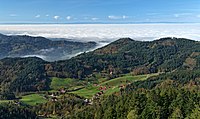
Photo from wikipedia
Mixing of sedimentary formation fluids with basement-derived brines is an important mechanism for the formation of hydrothermal veins. We focus on the sources of the sediment-derived fluid component in ore-forming… Click to show full abstract
Mixing of sedimentary formation fluids with basement-derived brines is an important mechanism for the formation of hydrothermal veins. We focus on the sources of the sediment-derived fluid component in ore-forming processes and present a comprehensive fluid inclusion study on 84 Jurassic hydrothermal veins from the Schwarzwald mining district (SW Germany). Our data derive from about 2300 fluid inclusions and reveal differences in the average fluid composition between the northern, central, and southern Schwarzwald. Fluids from the northern and southern Schwarzwald are characterised by high salinities (18–26 wt% NaCl+CaCl2), low Ca/(Ca+Na) mole ratios (0.1–0.4), and variable Cl/Br mass ratios (30–1140). In contrast, fluids from the central Schwarzwald show even higher salinities (23–27 wt% NaCl+CaCl2), higher Ca/(Ca+Na) mole ratios (0.2–0.9), and less variable Cl/Br mass ratios (40–130). These fluid compositions correlate with the nature and thickness of the now eroded sedimentary cover rocks. Compared to the northern and the southern Schwarzwald, where halite precipitation occurred during the Middle Triassic, the sedimentary basin in the central Schwarzwald was relatively shallow at this time and no halite was precipitated. Accordingly, Cl/Br ratios of fluids from the central Schwarzwald provide no evidence for the reaction of a sedimentary brine with halite, whereas those from the northern and southern Schwarzwald do. Instead, elevated Ca/(Ca+Na), high SO4 contents, and relatively low Cl/Br imply the presence of a gypsum dissolution brine during vein formation in the central Schwarzwald which agrees with the reconstructed regional Triassic geology. Hence, the information archived in fluid inclusions from hydrothermal veins in the crystalline basement has the potential for reconstructing sedimentary rocks in the former overburden.
Journal Title: Mineralium Deposita
Year Published: 2017
Link to full text (if available)
Share on Social Media: Sign Up to like & get
recommendations!